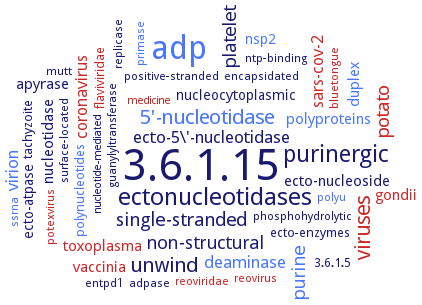3.6.1.15: nucleoside-triphosphate phosphatase
This is an abbreviated version!
For detailed information about nucleoside-triphosphate phosphatase, go to the full flat file.

Word Map on EC 3.6.1.15 
-
3.6.1.15
-
adp
-
ectonucleotidases
-
purinergic
-
viruses
-
unwind
-
5'-nucleotidase
-
potato
-
single-stranded
-
non-structural
-
purine
-
platelet
-
virion
-
ecto-5\'-nucleotidase
-
deaminase
-
sars-cov-2
-
coronavirus
-
vaccinia
-
nucleotidase
-
toxoplasma
-
gondii
-
apyrase
-
ecto-nucleoside
-
polyproteins
-
duplex
-
nsp2
-
ecto-atpase
-
nucleocytoplasmic
-
flaviviridae
-
tachyzoite
-
ecto-enzymes
-
polynucleotides
-
3.6.1.5
-
mutt
-
guanylyltransferase
-
ntp-binding
-
reoviridae
-
primase
-
encapsidated
-
positive-stranded
-
bluetongue
-
polyu
-
entpd1
-
phosphohydrolytic
-
replicase
-
reovirus
-
ssrna
-
adpase
-
potexvirus
-
surface-located
-
medicine
-
nucleotide-mediated
- 3.6.1.15
- adp
- ectonucleotidases
-
purinergic
- viruses
-
unwind
- 5'-nucleotidase
- potato
-
single-stranded
-
non-structural
- purine
- platelet
- virion
-
ecto-5\'-nucleotidase
- deaminase
- sars-cov-2
- coronavirus
- vaccinia
-
nucleotidase
- toxoplasma
- gondii
- apyrase
-
ecto-nucleoside
- polyproteins
- duplex
- nsp2
- ecto-atpase
-
nucleocytoplasmic
- flaviviridae
- tachyzoite
-
ecto-enzymes
- polynucleotides
-
3.6.1.5
-
mutt
-
guanylyltransferase
-
ntp-binding
- reoviridae
- primase
-
encapsidated
-
positive-stranded
- bluetongue
- polyu
- entpd1
-
phosphohydrolytic
-
replicase
- reovirus
- ssrna
- adpase
- potexvirus
-
surface-located
- medicine
-
nucleotide-mediated
Reaction
Synonyms
AAA-type nucleoside triphosphatase phosphohydrolase, ankyrin repeat-rich membrane spanning protein, cell division control protein Cdc48, DEAH-box Prp22 protein, DEAH-box splicing factor Prp22, DExH-Box NTPase, DR_0079, germ-cell-specific leucine-rich repeat protein, GP086L protein, HCR-NTPase, HrpB, HrpB NTPase, human cancer-related nucleoside triphosphatase, KAP NTPase, Kidins220, kinase D interacting substance of 220 kDa, LDBPK_100150, LdNTPDase2, LINF_150005200, LiNTPDase1, LMXM_10_0170, LMXM_15_0030, LmxNTPDase1, LmxNTPDase2, M86L protein, MC100R, Mg2+-dependent NTPase, More, Msm0858, NALP14, non-specific nucleoside triphosphatase, nonstructural protein 13, NPH I, NS3, NS3 protein, NS3FL, nsp13, NTP1, NTP3, NTPase, NTPase 1, NTPase 2, NTPase-I, NTPase-II, NTPase/helicase, NTPDase, NTPDase 1, NTPDase1, NTPDase2, nucleic acid-independent nucleoside triphosphatase, nucleoside 5-triphosphatase, nucleoside triphosphatase, nucleoside triphosphatase (NTPase)/helicase, nucleoside triphosphate diphospho-hydrolase, nucleoside triphosphate diphosphohydrolase, nucleoside triphosphate diphosphohydrolase 1, nucleoside triphosphate hydrolase, nucleoside triphosphate hydrolases I, nucleoside triphosphate hydrolases II, nucleoside triphosphate phosphohydrolase, nucleoside triphosphate phosphohydrolase I, nucleoside-5-triphosphate phosphohydrolase, nucleoside-triphosphatase 1, nucleoside-triphosphatase 2, nucleotide 5'-triphosphatase, P-loop NTPase, phosphatase, nucleoside tri-, PilB, PilT, PilU, polypeptide p41, protein NS3, PVA coat protein, PVA CP, PVx coat protein, PVX CP, Rad55B, RNA-dependent nucleoside triphosphatase, SHVp41, Sso0909, T4P motor protein, type IV pilus motor protein, YtkD


 results (
results ( results (
results ( top
top






